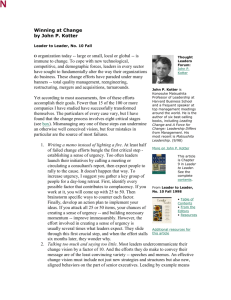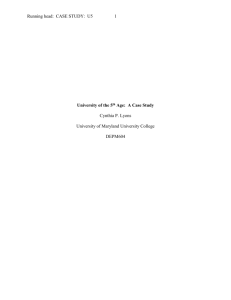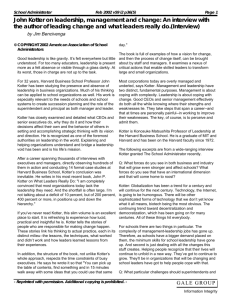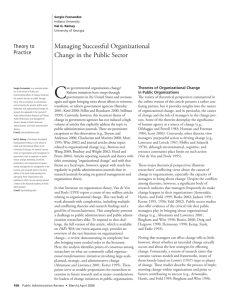Change Management
advertisement
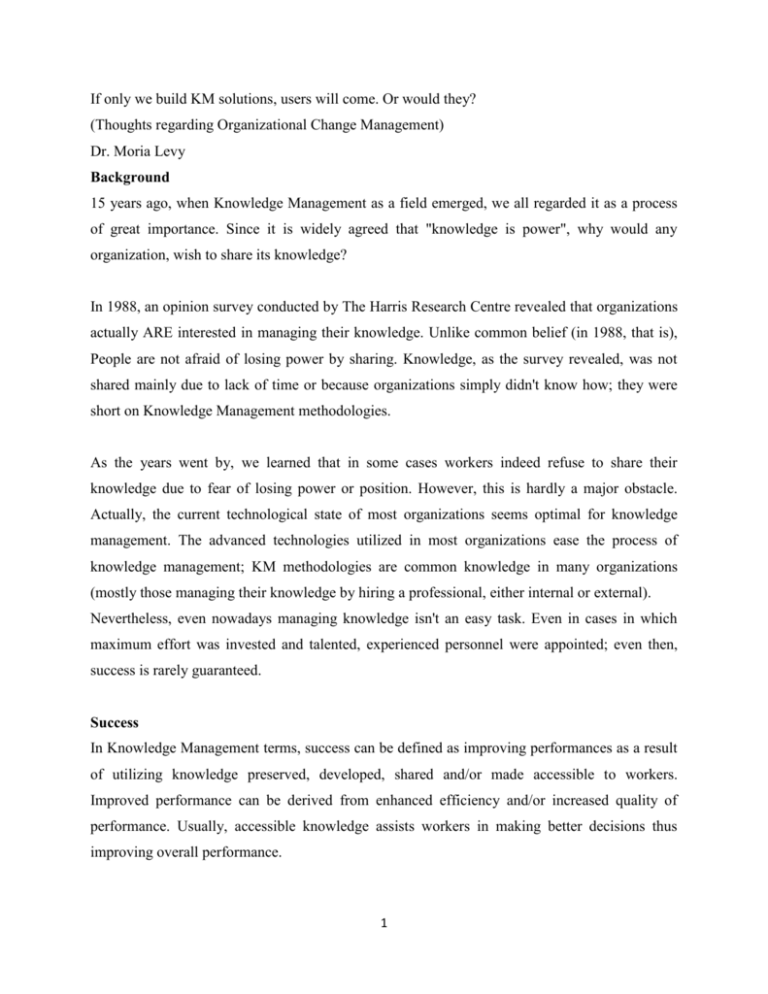
If only we build KM solutions, users will come. Or would they? (Thoughts regarding Organizational Change Management) Dr. Moria Levy Background 15 years ago, when Knowledge Management as a field emerged, we all regarded it as a process of great importance. Since it is widely agreed that "knowledge is power", why would any organization, wish to share its knowledge? In 1988, an opinion survey conducted by The Harris Research Centre revealed that organizations actually ARE interested in managing their knowledge. Unlike common belief (in 1988, that is), People are not afraid of losing power by sharing. Knowledge, as the survey revealed, was not shared mainly due to lack of time or because organizations simply didn't know how; they were short on Knowledge Management methodologies. As the years went by, we learned that in some cases workers indeed refuse to share their knowledge due to fear of losing power or position. However, this is hardly a major obstacle. Actually, the current technological state of most organizations seems optimal for knowledge management. The advanced technologies utilized in most organizations ease the process of knowledge management; KM methodologies are common knowledge in many organizations (mostly those managing their knowledge by hiring a professional, either internal or external). Nevertheless, even nowadays managing knowledge isn't an easy task. Even in cases in which maximum effort was invested and talented, experienced personnel were appointed; even then, success is rarely guaranteed. Success In Knowledge Management terms, success can be defined as improving performances as a result of utilizing knowledge preserved, developed, shared and/or made accessible to workers. Improved performance can be derived from enhanced efficiency and/or increased quality of performance. Usually, accessible knowledge assists workers in making better decisions thus improving overall performance. 1 When attempting to evaluate the success of a Knowledge Management system assimilated in an organization, we might find evaluating improvement of business output quite the complicated task. Obviously, there are cases in which output is more easily evaluated (e.g. customer service), yet in most cases this evaluation is far from simple. This task is challenging since linking improvement directly to Knowledge Management is not an obvious move, especially when a variety of altering factors can be equally responsible for this change. The market is constantly changing, be it our clients, our competitors, or our organization itself. More than one change constantly occurs in all three aforementioned fields. Hence, differentiating the Knowledge Management factor from is tricky. It becomes an even harder task when the work process is an ongoing, complex one. Some organizations wish to measure their success using usage as a parameter. This is an obviously superficial mistake: workers accessing shared knowledge do not ensure success. If the knowledge is not good enough, instructing our workers to use it will not yield improvement. It might possibly lead to the contrary. There are many prerequisites for success: Good content, well organized content, easy to use technologies, etc. For the sake of this article, I will assume that the relevant knowledge does exist, is saved in some knowledgebase, that the knowledge is organized, accessed easily and intuitively. I will assume that we are dealing with a technological platform in which knowledge is stored and updated according to predefined work procedures. I will focus on the challenge in drawing users. Users should actively participate in order for the knowledge to be used. Managing the change that may yield this participation is not as easy as it might seem. Some believe that a high-quality knowledgebase is a sufficient reason for workers to use it and actively participate in managing organizational knowledge. This is an industrial myth. In order to draw workers, hard work is required. Change must be managed in order to shift the workers' attitude and actions. Classic Change Management Theories Change management is a managerial approach dealing with changes required to make an individual, group or organization change habits or routines in a specific way. Professional Literature differentiates between change management theories concerning individuals and 2 Organizational Change Management theories. Some refine the definition, differentiating between other levels of change management teams or groups. There are four approaches to change management concerning individuals: 1. The behavioral approach: An approach that focuses on changing behavior by identifying desired behavior that yields desired performance. The elements of the current state of these performances are then analyzed and altered accordingly. Researchers/application models: Watzelweek, Weekland, Fish. 2. The cognitive approach: An approach based on the perception that people act according to the beliefs and values they hold. Succeeding in managing this change will stem in cognitive activity which in turn affects behavior, and will be based defining goals for our desired results. Researchers/application models: Beck. 3. The psychodynamic approach: This approach believes people go through a psychological process when experiencing a change. Different researchers offer different stages which are all essentially identical. Elizabeth Kubler Ross, who was the first researcher to develop a model of the sort, defined the following stages: denial, anger, bargaining, depression, and acceptance. Researchers/application models: Kubler-Ross, Satir. 4. The humanistic approach: This approach combines different elements of the three approaches above, while regarding each individual holistically. This approach is represented by Maslow and his well known hierarchy of needs, starting with basic physiological needs through safety, love and acceptance, and finally: self actualization. Researchers/application models: Maslow, Rogers. Besides the theories concerning individuals, there are theories concerning Organizational Change Management. Morgan examined these theories while presenting his own theory, claiming the different theories suit at lease one of the following metaphors: 1. Organizations as machines: 3 A process-related approach, strict organizational structure. Change Management: alike the theories concerning individuals. There might be some objection to change, but eventually through order and moderation, the change will be implemented. The change will be managed, according to this metaphor, by authority figures. 2. Organizations as political systems: This metaphor represents a separation between the operational conduct and the political system, seeing the latter as a higher, sperate level of management. Change Management: change will only occur if supported by a powerful figure, or a strong coalition. 3. Organizations as organisms: alike living organisms, organizations like, develop, change and adapt. Change management: changes should be conducted only as a reaction to some external need. Individuals and groups should be aware of the need for change in order for them to adapt to it. Companionship and psychological support are essential for successful change. 4. Organizations as ever changing flows: Organizations are complex systems and are part of a wider environment. Change management: change cannot be managed, it can only evolve. Managers are an integral part of the organizational environment; conflicts are an important part of the organizational development. Management is there to provide options, to allow. There are various practical implications for these metaphors. In 1951, Lewin coined a simple, yet critically important, Change Management model. It consists of three stages: UnfreezeMovement-Freeze. The first stage, known as the Unfreeze stage, consists of analyzing the current state of the organization, as well as analyzing change promoting and change inhibiting factor and presenting the desired status. The second stage, namely the Movement stage, deals with implicating the change. The third stage, the Freeze stage, deals with stabilizing the organization, setting a policy, rewarding succe and writing relevant standards. This model is an example of a model which implements the theories presented above. It is based on a combination of the "organizations as machines" metaphor (1) and the "organizations as organisms" metaphor (3). 4 Other theoreticians developed different models, included among others Bullok & Batten (with their plan-act-integrate model), Carnall (who highlights the managers as change leaders regarding processes, culture and organizational politics) and of course, Senge with the Piral attitude: Start small, moderately growing. New Change Management models There are several new names in the world of Change Management, such as Michael Fullan who focuses on leadership )" Leading in a Culture of Change"; "The Six Secrets of Change(". Another new name is Gary Hamel whose expertise is innovative management ("What matters now", "The future of Management"). These authors are promoting changes, more specifically Change Management.These authors write about innovative managerial leadership (as leadership and Change Management are closely related). There are other great thinkers in this field. Yet, if to pick one name internationally associated with the promotion of Change Management, it is undoubtedly John Kotter. The model offered by Kotter are recognized and implicated internationally in many leading organizations. According to Kotter, organizational change management consists of eight stages: 1. Creating a sense of urgency. 2. Forming a guiding Coalition. 3. Forming a vision and a change strategy. 4. Communicating the change and the need for it ; getting the workers' consent. 5. Empowering others to act. 6. Creating initial success, generating short term achievements. 7. Not giving up-Sustaining Acceleration. 8. Institutionalizing change: Creating a new culture of which the implicated change is an integral part. These Eight steps are not strictly serial, rather they are spiral: one begins with step 1 and advances, yet sometimes reversing and skipping are required. That's fine. Yet kotter didn't only create a model. Years after the model he developed was implicated in nearly every 500 international fortune company, he was still not content. He tried to understand 5 why most organizations that attempt to initiate a change don't reach the finish line, never completing the implication process. Kotter bravely conducted research in approximately 250 organizations that implemented the process yet didn't succeed in completing the process. He attempted to understand what difficulties these organizations faced and in which specific stage. Surprisingly, Kotter's research revealed that most organizations fail to complete the first of eight stages (!!) either due to organizational complacency or, on the contrary, due to a sense of urgency to complete this stage successfully. Kotter decided to examine this model more thoroughly. In 2008, he published the aptly named book “A Sense Of Urgency” in which he suggests how to methodically create a sense of urgency in organizations in order to continuously promote change. Another useful, innovative model was developed by Jeffrey M. Hiatt from The Change Management Learning Center and was presented in his “Change management: the people side of change” in 2003 (co-written with Timothy J. Creasy). This model is one component of an inclusive Change Management theory developed by the two. The model is titled ADKAR, an acronym of the 5 elements that can inhibit organizational change management: A-Awareness: Every worker must be aware of and comprehend the importance of said change. D-Desire: Every worker must want to support and participate in this change. Knowledge: Every worker must know what he must do in order to change. A-Ability: Every worker must possess the ability to exercise new skills and behavior as required in order to perform this change. R-Reinforcement: Tools to assess the internalization of the change. 6 When dealing with Change Management, one must present the group with the main inhibiting factors in each given stage and setting. Change must focus on these factors. The last innovative model I wish to review was recently presented by the Heath brothers. These American-based brothers, one a Stanford professor (Chip) and the other a senior lecturer from the CARE center in Duke University (Dan), have already published three books on various management themes (all three highly recommended both for reading and implementation). In the second installation in their trilogy (as of 2015), titled “SWITCH: How to change things when change is hard”, they refer to three scales one should use when managing substantial Change Management (whether individual or organizational): 1. The rational scale (in their words, directing the cyclist): Creating a clear direction to the destination Finding positive elements in the current situation Defining specific tasks for critical stages 2. The emotional scale (in their words, Get the elephant moving in the right direction): Connecting with emotions. Shrinking the change. Growing the people. 3. The environmental scale: Make small amendments and adjustments in change-oriented environments Create new habits in the new environment Create peer pressure in order to implement the change. They obviously have many tips and suggestions to offer, yet the most innovative ones are by far those related to the environmental scale. Implementing all theories and models when managing knowledge Getting workers to manage knowledge (share knowledge with others and consume knowledge shared by others) is not a simple task at all. There is no single formula for success, and there is no guarantee that a formula proven successful in one setting will be successful in another setting (sometimes in the same organization). 7 What I've learned from my experience is that is best to 'extract' the most unique yet practical element of each model, and create a new, blended model. The optimal blend, in my opinion, in the world of Knowledge Management (specifically, when dealing with Israeli organizations): 1. Kotter: Making sure a sense of urgency is indeed felt in the organization and management does indeed desire to incorporate this change, as well as understands why a change is due and thus Knowledge Management is required. Making sure management commitment actually exists. As cliché as it might sound, without this commitment- no change will ever be successfully implemented. 2. Senge: performing changes as moderately as possible. 3. Hiatt: Analyzing where to focus the change (based on the ADKAR model). Dividing the organizations into subgroups can reveal the needs of each group. There may be some who require more knowledge; others might need a motivational boost. Review the whole process every two months and adjust the messages you feed each group. I've reviewed and experienced too many cases of organizations that invested much effort and resources in advertisement without once analyzing what steps should be taken, and who the target audience of this step is. An attractive deal or product is is not necessarily effective. 4. Heath: Easing the Change Management process by adjusting the environment to support it. Making people walk in our lane, in which change is easily implemented. For example, inserting specific hyperlinks to the knowledgebase into existing patterns/forms. These links make the knowledge more accessible to the workers, and thus assist him in filling this form or use this form. In some cases, updating some specific section of this form can be used to make the workers use this knowledge while seemingly an integral part of this form/pattern. 5. There is a debate in the world of Knowledge Management whether to include the final stage (the Freeze stage) of Lewin's model in today's work culture. In modern society, and more so in the world of Knowledge Management, promotion of utilization of knowledge is an infinite process (or at least, one of an unfathomable length). The more we succeed, new needs appear, new content emerges, and new tools are discovered or invented. All these are accompanied by new Change Management. There might be a starting point, but there is no 8 finish line in sight. This might not be the optimal setting for an organization to operate in, yet this is definitely the current reality to which we must learn to adapt. 9 Conclusion This article elaborated on the importance of Change Management and presented different theories and implementation models. Towards the end of this article, a hybrid model combining several elements of the various models was discussed afressing the need for Knowledge Management.. There is no scientific proof that this model is the single correct model to use when managing knowledge. What can be presented is the experience of many organizations that successfully implemented this model in Knowledge Management projects. Nevertheless, we must further research and follow new approaches that are still being developed in an ever changing world of Change Management, and examine how they contribute to the model and continuously improve it. Our work is yet to be done. References Cameron, E., & Green, M. (2004). Making Sense of Change Management. London, UK: Kogan Page Limited. Fullan, M. (2001). Leading in a Culture of Change. San Francisco, CA: John Wiley & Sons. Fullan, M. (2008). The Six Secrets of Change. San Francisco, CA: John Wiley and Sons. Hatch, M. J., & Cunliffe, A. L. (2006). Organization Theory. New York, NY: Oxford University Press. Heath, C., & Heath, D. (2010). SWITCH: How to Change Things When Change is Hard. New York: Broadway Books. Hiatt, J. M., & Creasey, T. J. (2003). Change Management: the People Side of Change. Loveland, Colorado: Prosci Research. Kotter, J. P. (2008). A Sense of Urgency. Boston MA: Harvard Business Press. Kotter, J. P. (1996). Leading Change. Boston MA: Harvard Business Review Press. Watzlawick, P., Weakland, J. H., & Fisch, R. (1974). Change: Principles of Problem Formation and Problem Resolution. Norton. 10 11







